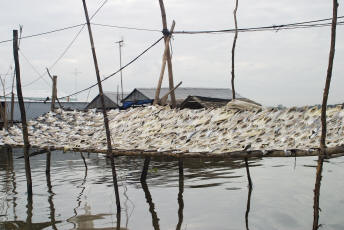|
|
|
|
Dec 28, Sun- We are on the move early in the morning, having left Hoi An for the Da Nang airport, we arrived in Ho Chi Minh City by 9:30 am. We spent no time in the city and instead, continued on by car down to the Mekong Delta. Immediately we are aware of the change in landscape. While very flat, the land is lush and green and the people primarily farm rice or fish for their livelihood. Outside of the city of Vin Long, we visited the Van Thanh Mieu Temple. This is an active Buddhist Temple with monks in residence and training.
Dec 29, Mon - We depart by boat early for the
two major floating markets west of the city: Cai Rang and Phong Dieh. Along the way we catch a glimpse of the local housing and businesses operating
along the water.
Chau Doc, not far from the Cambodian border, is situated
on the right bank of the Song Hau Giang. The area is a melting pot for a
large Khmer community which combines with local Chams and Chinese. It was
because of Pol Pot's Khmer Rouge attacks into this delta area that precipitated
the Vietnamese invasion of Cambodia in 1978.
Although we stayed at another Victoria Hotel, the Chau Doc
property was nothing like our previous experience. We did have fun with
the baby Gibbon monkey who made his home at the the hotel. Dec 30 - Tues. Known for its floating fish
farm villages, we take a boat out early in the morning to view these
communities. Living in houses built on metal oil barrels/drums or small
boats, the villagers survive on and prosper from fishing. Metal nets under
the houses facilitate the capture of fish.
Floating platforms are used for drying fish in quantities. 
Besides capturing fish, villagers also raise fish. Inside
one of the houses, we observe a family cooking the food for the fish (shrimp,
bugs, greens) and the feeding through openings in the floor of the family's
living quarters. Once the fish are large enough, they are either dried (as seen
above) or shipped alive in large wooden boats in which the cargo holds are left
open to allow the river water to free flow, bringing oxygen and nutrients to the
fish. The mudfish and catfish are usually taken to processing plants
closer to Saigon and then shipped on the US. Because of the high tariffs
on catfish in the US today, fish farmers in Vietnam are not as prosperous as in
the past.
We cross the river to visit a local Cham community (Chau
Gian District).
In addition to the mosque and school, the Islamic
influence is visible throughout the village. However, the community operates
under a matriarchal system wherein the women work and control the money
while the men drink and engage in cock fighting.
As we move through the canals on our return by boat, Cham
houses, built on stilts, line the water's edge for use of giant fish nets along
side of their houses. We watched some local smuggling, probably cigarettes and
other heavily taxes goods, being quickly unloaded as we moved down the river.
We completed our boat ride, circling back into town and by
the local market. The remainder of the day would be spent driving back toward
Ho Chi Minh City. On our way to Cao Lanh, we spent considerable time on
two different car ferries, including the My Thuan ferry.
Cao Lanh is the burial site for Ho Chi Minh's father,
marked by a giant concrete clam-shaped monument. We also pass a large communist
war memorial built in memory of the those who were part of this Viet Cong
stronghold during the American War.
We continue on to the Xeo Quit Tourist Jungle, the perfect
terrain for hiding the Viet Cong guerrillas during the American War. The
swamp-like landscape made it impossible to build a tunnel system similar to Cu
Chi (see Dec 31); however, the policies of "going without trace, cooking without
smoke and speaking without noise" sustained those living here during the
war.
A camouflaged look-out platform is was used for
viewing the adjacent mined and trip-wired fields. Our guide,Truan, demonstrates the finer points of crossing a
monkey bridge. Jon and I did not attempt this since we knew we would wind up
with the ducks. |
|
|